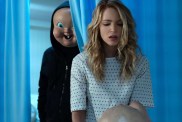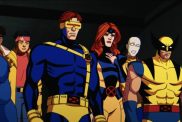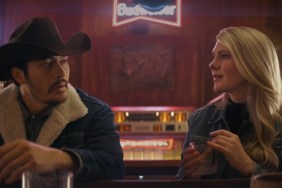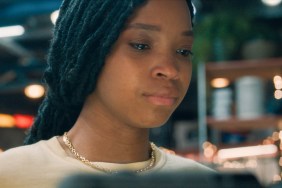ComingSoon Editor-in-Chief Tyler Treese spoke with The Texas Chain Saw Massacre creative director Ronnie Hobbs and Gun Interactive CEO and studio head Wes Keltner about the asymmetrical multiplayer horror game. The duo discussed working with Kim Henkel and balancing the game. The upcoming DLC releases on Tuesday, October 24.
Tyler Treese: You guys have the Greg Nicotero DLC pack coming out. How did that collaboration come about? He’s an icon. He’s worked on so many great films and on some later entries of the franchise.
Wes Keltner: I worked hand-in-hand with Greg on this. So how did it come to be? We knew we wanted to … you only have a finite amount of characters to work with if you’re looking at the ’74 film. When Ronnie first sat down and started writing the design on this game, one of the things that he brought up to me was that we only have a handful of things here, so we need to look at like how we can expand on this. Luckily, Ronnie was working directly with Kim Henkel to start discussing what new characters could come into the game.
One of the things I brought up was that we always love working with other horror people — people who like to make things. It was a pretty short list and that was the top of the list of someone that was kind of a dream person to work with. I respect Greg and that hustle of coming up from working in practical effects all the way up into full-on filmmaking director. That kind of thing was pretty fascinating to me. I thought he would be a great person to work with because think how we function and how we think is quite similar to some of the approaches that he has taken in looking at his career. So it was kind of a shot in the dark to just be like, “I wonder if this is something that Greg would be interested in.”
And we got introduced and we got on a call like this, and I started laying out what we wanted to do. It was like the kid in the candy store for him. He was delighted to touch the IP and to be with it again and work on it and understood what that meant to make a new Leatherface. He really got into the details of that sort of story of, “What is Leatherface, and why is he dressed the way he dresses?” Just all of that, because he really understood that that character in the film is, in and of itself, creating its own characters and the looks — from the butcher wearing the apron to the pretty woman and old lady. All those things are characters that Leatherface wants to play. So that’s where we started in that conversation: “What’s another character that Leatherface would come up with?” And that sort of kicked off that creative discussion.
You have the rights to the original film. A lot of fan requests have been of stuff from down the line, but you have the rights to this one. Restrictions can force you to be creative and we’ve seen people really do their best work when being within confines. When you’re thinking about content and what you can add to the game, things like this original skin probably wouldn’t have been done if you had all the access to the rest of the thing because you’d be doing more straightforward adaptations. How has being forced to be a bit more creative and think outside the box changed your approach?
Ronnie Hobbs: Like Wes alluded to earlier, we worked with Kim Henkel very closely on pretty much every aspect of this game, but the biggest area that we used him for and that we collaborated with him on were the characters in the story. Obviously, we didn’t want to just retell the story of Franklin and Sally and Pam and Kirk, right? So if you do, if you tell that story alone, you know how that story ends, right? If Sally’s not the last one alive, are you upset? There are all these restrictions that, if we did that film exactly, would be very, very limiting for us. So our mantra of “it has to be a prequel and it has to take place just a few months before the film” really allowed us to open up just a whole new can of worms.
And that’s how we created all of the new characters. That’s how we were able to create the new family members who were around before the film but for whatever reason — a lot of the reasons people don’t know yet — why they weren’t there in ’74. So for me, it was an incredible experience to work with Kim and create this whole new … not only just cast of victims that people have grown to love and to tell the story of the Flores sisters and all this cool stuff, but also the new family members that we worked on with Kim Henkel. So it was pretty cool. Kim was basically like, “Hey, I have this character bible, essentially, of characters that no one knows about that were going to be in the original film, but got cut for whatever reasons.”
So we read that and we picked out a few characters that we liked the description for them, and then we worked together to visually design them and come up with their personalities and all their VO lines and how they move, how they act, and what they look like. But we also came up with brand new characters completely that Kim not only signed off on, but kind of helped us just get to the finish line, as well. So from a creative standpoint, we did a whole bunch of new stuff for this because we felt almost a necessity, if that makes sense.
With the Nicotero Leatherface DLC, this is a big bundle. It obviously has the new character, the skin, the Signature kill, and the exclusive saw with some custom sounds. Will all of the premium content going forward be these types of bundles that people can expect?
Wes Keltner: Well, I mean, we haven’t announced what else is going to be coming down the pipeline. Right out the gate, this is one of the most premium — especially for the amount of time and work that went into it … I know on the surface some people would just label this as a skin and would sort of write it off, but it represents over a year’s worth of work, sitting hand-in-hand with Nicotero. We literally were writing out the whole backstory of this version of Leatherface because, again, I think he’s a complicated character. To bring those complexities to life, you have to kind of get into the DNA of that character and start thinking [about] what makes them tick and why would they want to dress up and why do they dress up and why do they choose this clothing and not that clothing, etc. When everyone else around them is all wearing the same clothes pretty much all the time, why would Leatherface feel the need to do this?
All those discussions … sometimes we had Zoom calls just like that, where we were just picking that stuff apart and then we would break for two weeks and come back and sit with Greg and I and go over those answers that we answered ourselves and see where that direction takes us. So it was a long time to create those things. And then choosing the saw and that took mountains of research to find the one that I wanted because I knew I wanted a different profile to the saw because the is a little more aerodynamic-shaped, I guess you might say. It’s sort of rounder, it’s softer, that model. So I wanted something that felt bigger and more jagged and more dangerous, even just looking at.
That’s where we, we stumbled upon the saw that we have, which is about … I think it’s nearly 20 years earlier. It’s like a late ’50s or so logging chainsaw, then setting with Ross [Tregenza], our composer and sound designer for the game, and discussing what this saw would sound like and starting with sounds that we captured from the Poulan, but then also capturing and getting other saw sounds and other saw libraries and twisting them together and changing octaves. We were adding all kinds of stuff to get the exact sound. Whenever they entered a match, if they just heard that saw, I wanted players to know, “Oh, it’s Nicotero,” and not have to see it. I want them to hear it and have that visceral response. So again, it was a lot of work.
And that’s why it’s a premium skin that has a higher price tag than you might find from some of the other content that we release. But we really also wanted to come out with a punch that let people know that authenticity matters to us and we take a lot of pride in the work that we do and that there are artists that work here and we don’t leave any stone unturned. We go deep on the stuff that we create to assure that whenever you look at it, it stands alone. When you try to compare us to either other games or other content that’s on the market, there’s very little you’re going to find that feels cookie cutter. Everything’s original and everything fits in the world the way it’s supposed to. And that takes talent and time to do it.
One thing I really did like was that you guys were so transparent. You laid out, “This is how much new characters are going to cost and maps are going be free.” How important is being transparent when building a community for the long term? If a community doesn’t feel like they’re being heard or being respected, that can go away very quickly.
Wes Keltner: Yeah, I mean it’s crucial here. We have a lot of meetings talking about just that — the community and the sentiment around it and what people are looking for, what they wish the game had or what we wish we could do and already discussing that wishlist as it fit into where the community is right now. It’s very important to us here. It’s a topic that comes up a lot. That’s the thing about transparency though, is, sometimes, you say things people don’t want to hear, and that’s the hard part about it. If you are truly being as transparent as you can as a studio, you’re going to say things that people don’t want to hear and they get their back up about it, they get upset about it, they complain about it.
But if I only were bringing you good news, you’re only hearing half of the story and I don’t think that ever sets up a good relationship between us — the people who are creating — and the community == the people who are consuming and enjoying the things that we make. If I’m only bringing you good news, that’s not the full picture. You need to know that. There’s a bad side, too. It’s not all great, and we have to do that. We have to say those things. Some people can take that and some people can’t.
What’s so cool about the collab with Greg is how it shows that you are working with these outside legends and embracing just how diverse horror can be. Have you already internally been talking about some other dream collabs that, if things just come together, you would like to see down the line?
Ronnie Hobbs: It’s going to sound kind of silly, but yeah, we have those conversations probably at the very beginning of the project and we’re having conversations about things 10 years from now. So that is something that’s always on our mind is, “If we take on this project two years from now, who are the people that we want to work with on it? What can we do with them?” There’s not a whole lot of reactionary stuff here, believe it or not. We’re playing these games a year or two in advance before we even start working on them. The same goes for the people that would fit well within that project.
So we have our favorite horror celebrities that we love and these icons in the industry that we’re dying to work with too. We’re already thinking about things for Texas and beyond. I feel like you kind of have to do that if we don’t want to be playing catchup. We want to be ahead of the curve on those things. And yeah, and Nicotero’s just one sign of something that was big internally and Wes and him just hit it off and they just had perfect designs that, when they show them to, you’re like, “Yep, do it. No feedback. It’s perfect.” [Laughs].
Yeah, just about every aspect of the game lands on Ronnie’s desk for approval. That one was one of the smoother ones that went through. But it also just speaks to that when Ronnie and Kim sat down to start designing a character in the game, be it a new killer or a new ,family member or a new victim, that those discussions … early on, if it’s someone no one’s ever heard of the gears are already turning for Ronnie. “Yeah, but who do I cast for that? Who is that? Who’s going to bring this to life? “And sometimes it’s the body performance, the motion capture, or it’s the voice performance. When you’re doing a VO session, sometimes you can luck out and find someone who can do both, but that’s rare. You usually have to get two people. So now you’re looking at two people in real life and trying to decide, “If I combine these two things, does it make this character that, right now, is just a concept?”
You sit with with Kim and you discuss the character and you discuss their background and even the subtleties of like, what do they sound like? What part of Texas are they from? Because there’s different accents even within. Then it’s education level to clothing that they would wear to what’s their hairstyle and how do they carry themselves as a character? That’s all thought out and then crafted into a concept piece. Now you have this 2D design of a character and you have to go find two humans that take direction, both on body performance as well as vocal, and that they’re going to react well when they see Kane [Hodder] as Leatherface or when any other killer shows up. It’s moving a mountain to bring this character to life, to go from nothing to what’s there.
And that falls on Ronnie’s shoulders to be able to do that. He’s there for every single step of that from the first time that ink gets to the paper all the way to sitting in the mocap studio and yelling, “Action!” That’s what Ronnie’s bringing to life. So it’s a long process, from sitting down with Kim to playing it in the game. That was every bit of two years when we first started, right before we even saw those things come to life. So yeah, it’s a big undertaking, but we don’t cut corners through any of it. Because what makes our game unique is every family member has a bespoke personality and animation set. They don’t share animations, they all move differently, they walk differently, they attack differently. They all have their own script, their own VO actors that do those things. That really immerses you in the space and you feel something. You feel a connection to that character. So again, it’s where we border on being obsessive.
I thought it’s been an interesting approach. I’ve found it pretty refreshing is that you guys don’t have a giant roadmap to point to where people are being promised all this stuff down the line. You’ve been waiting until closer to when it’s actually going to be available and it’s been very measured. Can you speak to that approach?
Wes Keltner: What you never want to do is make a promise and then something falls through and you can’t deliver on it. What I think a lot of people outside of devs don’t realize is that there are so many things not within your control as a studio that can cause something to not happen. You could do everything right on your side, but then something down the line doesn’t come to fruition. Then you have to figure out, “How can we now back up and take this in a different direction?” There are so many things, from third-party support to something like this physics plugin that you use for this version of Unreal for no longer supports, so are you going to rebuild it?
What are you going to do? That’s going to set you back three months and probably 300,000 to 400,000 you want to do that? It messes up your DLC cadence and you promised this roadmap that people are literally circling on the calendar, “I can’t wait for this thing.” You miss that because of something that’s out of your control. Now there’s a trust thing that starts to fall apart and now you’re on your back foot trying to talk to folks to say, “Oh no.” And you can’t just like start throwing all your partners under the bus and say, “It wasn’t us. It was them.” That’s not good. It wouldn’t do well for anyone to tell that story.
We find that it’s better to take a more artisanal approach to this. The stuff that we want to build and the stuff that we think is the right thing to build. We go head down and build it until we know it’s done, certified, whatever, right? We’ve checked that box. Now we can show people the thing that’s coming soon to the game. That’s where I think you can get in trouble, when you start showing that months and months in advance. Showing them a roadmap, you could get caught with your pants down in those situations. But we are not a 100 man team that can do things like that. It’s a smaller team, so it’s a smaller approach. While we still are always looking way in advance on how the stuff that we know we want to do with the games that we make, sort of lifting a veil and showing that whole thing and saying, “Hey, on this date, we don’t know that it’s going to happen.” Then we know we can do everything on our side to get it done and get it ready. But then it goes somewhere else and it’s out of our control. So that’s the part that’s like … I don’t like to make that promise if we can’t keep it, because you break the trust and it’s a big hill to climb back up to get that, to get your player base to say, “I believe.”
In regards to the game’s onboarding process, how’s it been trying to balance picking between victims and killers and making sure matches are being filled with both?
Ronnie Hobbs: I guess for any online multiplayer game, that’s a constant monthly battle that you’re trying to look at data and you’re trying to figure out if people are playing the game the way that you designed it. The answer usually is they don’t. [Laughs]. Because people are people. That’s the beauty of our games — it’s not AI and that unpredictable things happen. That’s what makes our game have replayability with all the different multiple killers all driven by people and their emotions and their decision making. Go back to your first point of tutorials. We did put some tutorials in there but we didn’t have a single-player “hold your hand” tutorial. The basic reason behind that is we design our games so that they’re not linear in that you can go out and you can make mistakes and you can learn on the fly. Failing is the best way to learn in this game. That’s a design approach we take — “Here’s a world, go play in it.” Just like in any horror movie, if you found yourself in this situation, we want to give you the options that you would think would exist in real life, almost. A lot of natural thinking occurs for the player, so we don’t have to handhold them on just the basics of survivability. “Oh, there’s a door, I’d better lock it. Oh, there’s someone chasing me. I better run. Oh, there’s a shadow. I better get into it.”
It’s all basic human emotions that kind of drive our multiplayer games, even on Friday 13th. So that kind of takes care of itself. We don’t have to go super in-depth unless you’re talking about perks and how to equip them and how to use abilities. That’s a different area that we try to focus on. But the basic premise is people understand it because it’s a natural thing to do is be scared and try to survive. As far as family members versus victims, we’ve actually seen a lot of data that it fluctuates. We think people, for whatever reason, are switching size because they want a new experience or they get better at victims faster than they’re getting at family members, or they find an XP exploit or they want to grind for something on the victims. So we look at all that data in real time and, honestly, it’s to be expected on any multiplayer game. We imagine it would go on until the end of time, trying to buck this side, decrease some of this, add an ability something here, do some things that kind of keep it fresh. That’s our goal moving forward, is to try to keep both sides offering something new.
Wes Keltner: It could kind of ebb and flow, as well, through the lifespan of a game. As people continue to level and get higher level, you start to see the teeter-totter start to level. Then, sometimes, it can kind of bounce around with player skill and hours played if a new character comes out — there’s a lot of variables that can get thrown into that start to shift that. We never want to grab the balance knob and crank it. We’re making subtle movements because it’s like ripples in a pond, right? Those waves get bigger. When it gets further out, you’ve got to make incremental changes. While we see that and look at that data, some of those things, just over a time period, you start to see a balance shift organically.
So it’s never a great idea to, as soon as something occurs where a shift starts to begin and people start to ask for one thing, for us to just grab the knob and turn it and crank it up. That can cause for a lot of instability for sure. To sort of capitalize what Ronnie was saying, one thing we always talk about here is … I’m sure that when you were growing up, maybe you were too young to watch horror or maybe you were in high school or you were in college and you’re with all your buddies and you’re watching a horror movie and the credits roll and you turn to look at each other and someone says, “Well man, what would you have done?” We make games that answer that question. If you put training wheels on that, how is that horror? I’m saying with a tutorial, if you really handhold them through the whole experience, then you didn’t have a horror experience. So we try to rely back on that question that everyone’s asked and try to build our games to help you answer that question.
It seems like horror’s always underestimated, both in film and gaming, but the fanbase always comes out. It’s always supporting within the genre. How has it been knowing just how loyal that fanbase is since you have this huge built-in audience?
Ronnie Hobbs: One thing you can count on every year is, maybe not so much lately, but sci-fi and horror always being the redheaded stepchild of the film industry. Even as popular as Star Wars is, it still doesn’t get the respect that dramas do. Horror never gets the respect that dramas do. It’s a given that the sci-fi nerds — which I’m one — and the horror nerds, they get kicked into a corner, right? They’re not taken seriously. The same thing happens in games. The same things happen all across media. But one thing, because we’re in that industry, is we know how hardcore the fans are and we know how loyal they are. All the horror conventions, they all live on the back of all the fans who show up to every one of them and get the autographs of all their favorite stars.
So I always look at those two as similar — sci-fi and horror. But we knew that before we even started making Friday 13th. We knew because we’re part of that group. We know how loyal those fans are. So it’s interesting to see that now our games that we make are introducing new people to horror and they are coming on board. People who normally don’t like horror are playing our games because we make them approachable. You can have fun in our game and live for just two minutes and have a good time and go, “Oh God, that was the perfect amount of scary.” People who don’t even like horror play our games now, and that’s the goal. I think it’s same reason people watch horror films during Halloween. They want to be scared, but only during a couple minutes at a time. So that’s our approach.










